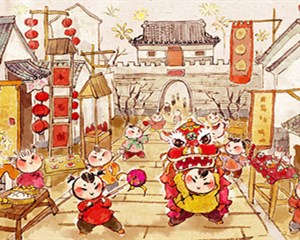春節(jié)年的來(lái)歷
I.High-value words 單詞表
1.Chilly寒冷的adj.
2.Festive節(jié)日的adj.
(注:be in festive mood 沉浸在節(jié)日的歡樂(lè)中/ festive costumes節(jié)日盛裝)
3.Swelling 腫脹 n.(U.) (注:reduce the swelling 消腫)
4.Ravage 破壞 vt. (注:a country ravaged by civil war 遭受內(nèi)戰(zhàn)重創(chuàng)的國(guó)家)
5.Livestock 牲畜 n. ( U.)
6.Gunpowder 火藥n. ( U)
7.Legendary傳奇的 adj.
8.Awaken 喚醒 vt. (注:awaken me 叫醒我)
9.Plentiful 豐富的 adj. (注:a plentiful harvest豐收)

II.Source Article 原文正文
(Traditions of Chinese New Year / 中國(guó)新年傳統(tǒng))
Today we'll be taking you through some of the most important traditions of Chinese New Year and historical background.
今天我們將帶你領(lǐng)略一些最重要的中國(guó)新年的傳統(tǒng)和歷史背景。
We will look at some of the legends behind Chinese New Year and how to celebrate it.
我們將看看中國(guó)新年背后的一些傳說(shuō)和如何慶祝它。
Here in the US and Chinese across the world.
在美國(guó)和世界各地的中國(guó)人。
The Chinese have specific ways to celebrate their new year.
中國(guó)人用特殊的方式來(lái)慶祝新年。
If you walk down the street in Chinatown during Chinese New Year, you see a variety of ancient traditions such as red banners, firecrackers and lion dance performances, streets are filled with lively celebration.
如果你在中國(guó)新年期間走上唐人街,你會(huì)看到各種各樣的古老傳統(tǒng),如紅色橫幅,鞭炮和舞獅表演,街道上充滿了活潑的慶祝活動(dòng)。
However, legend has said that the new year has not always been a time of festivity.
然而,傳說(shuō)新年并非一直是歡慶的日子。
An Asian Chinese story told a chilly start to this festive holiday, it begins with an ancient Chinese beast called Nian.
一個(gè)亞洲的中國(guó)故事講訴了這個(gè)喜慶節(jié)日的寒冷起源,它始于一個(gè)叫“年”的中國(guó)古代怪獸。
Every New Year Nian would rise from swelling in the sea to ravage Chinese village in livestock and hurting people.
每一年新年,“年”會(huì)從上漲的海里出來(lái),在中國(guó)村莊里肆虐牲畜、傷害人類(lèi)。
The villages soon found out from a wise gray-haired old man that the only way to scare the beast away was to set off firecrackers and light lamps and to hang red banners on each door.
明智的村莊很快從一位頭發(fā)花白的老人那里得知,嚇跑野獸的唯一方法是放鞭炮,點(diǎn)燈和在每個(gè)門(mén)上掛紅色橫幅。
As the story goes, this was the beginning of a tradition that would last thousands of years.
據(jù)說(shuō),這就是將持續(xù)數(shù)千年傳統(tǒng)的開(kāi)始。
So this story leads to the creation of many of other traditions for celebrating Chinese New Year, let's take a look at some of these traditions.
這個(gè)故事產(chǎn)生了許多其它的為慶祝中國(guó)新年的傳統(tǒng),讓我們來(lái)看看其中的一些傳統(tǒng)。
We're gonna try now to tell us why firecrackers are so important to kick off (啟動(dòng)) the new year celebrations.
現(xiàn)在我們要試著講述鞭炮為什么在新年慶祝活動(dòng)中如此重要。
For many Chinese, New Year celebrations will not be the same without firecrackers.
對(duì)許多中國(guó)人來(lái)說(shuō),新年慶祝活動(dòng)沒(méi)有鞭炮是大不一樣的。
This tradition originates from ancient China as a Chinese was the first to invent gunpowder as early as during the ninth century.
這些傳統(tǒng)源于中國(guó)古代,作為中國(guó)第一個(gè)發(fā)明火藥早在九世紀(jì)期間。
It was believed that ghost, bad spirits and even the legendary monster called Nian that came out attack people during a new year were afraid of loud noises, so the Ancient Chinese would fill bamboo stems with gunpowder to make smell explosions to drive away Nian, evil spirits and bad luck.
據(jù)說(shuō)鬼魂、惡靈1甚至傳說(shuō)中的怪獸“年”,“年”攻擊人在新的一年害怕噪音,所以中國(guó)古代竹莖充滿火藥氣味爆炸趕走年,惡靈,壞運(yùn)氣。
Another popular traditional belief was that the noise from the firecrackers would awaken the sleeping dragon that fly across the sky, bringing plentiful rain for their crops.
另一個(gè)流行的傳統(tǒng)信仰是鞭炮的聲音喚醒了沉睡的龍,它飛過(guò)天空,給莊稼帶來(lái)充足的雨水。
Today in most countries for safety issues, it is illegal for individuals to light firecrackers, but this tradition persists to make it safe and enjoyable (令人愉悅的) for the public.
今天在大多數(shù)國(guó)家,由于安全問(wèn)題,個(gè)人放鞭炮是違法的,但是這些傳統(tǒng)依舊在安全的愉悅著大眾。
關(guān)注微信公眾號(hào)<英用edo>, 搜“課程”和海量干貨
加微信(fridaymood),可咨詢課程,或進(jìn)打卡群,第一時(shí)間參與英用所有學(xué)習(xí)活動(dòng),為國(guó)人開(kāi)口說(shuō)英語(yǔ)樹(shù)立榜樣吧!











